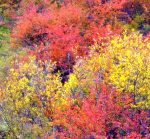 We often associate fall color with trees but there are some outstanding deciduous shrubs that provide impressive displays of yellow, orange, red and purple foliage to the autumn scene. True, shrubs tend to be smaller than most trees and therefore have less impact when standing alone, but mass them or use one to a few in a small space and you can have a sensational display that can bring weeks of pleasure in the garden just when most other plants are going dormant. Photo Credit: Zoom Zoom, Wikimedia Commons
We often associate fall color with trees but there are some outstanding deciduous shrubs that provide impressive displays of yellow, orange, red and purple foliage to the autumn scene. True, shrubs tend to be smaller than most trees and therefore have less impact when standing alone, but mass them or use one to a few in a small space and you can have a sensational display that can bring weeks of pleasure in the garden just when most other plants are going dormant. Photo Credit: Zoom Zoom, Wikimedia Commons
Japanese Maple (Acer palmatum heptalobum)
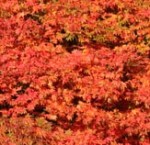 There are many beautiful Japanese maples and this is one of them. With its elegant form and superb autumn coloration it is a fine choice for a courtyard, cottage garden, or Japanese garden. Its palmate leaves are 2-5” long and have seven to nine long, tapering lobes with finely serrated margins. Bright green when they emerge, the leaves turn orange and then scarlet when temperatures change, and persist well into late fall. The small flowers produced in spring are pendent, purple-red, and followed in autumn by red-winged fruits (samaras). Plant in a place that is sheltered from winds to avoid leaf scorch.
There are many beautiful Japanese maples and this is one of them. With its elegant form and superb autumn coloration it is a fine choice for a courtyard, cottage garden, or Japanese garden. Its palmate leaves are 2-5” long and have seven to nine long, tapering lobes with finely serrated margins. Bright green when they emerge, the leaves turn orange and then scarlet when temperatures change, and persist well into late fall. The small flowers produced in spring are pendent, purple-red, and followed in autumn by red-winged fruits (samaras). Plant in a place that is sheltered from winds to avoid leaf scorch.
Type: Deciduous shrub or small tree
Height: 16′
Light: Partial shade to full sun
Soil: Average, humus-rich, moist, well-drained
Hardiness: Zones 5-8
Red Chokeberry (Aronia arbutifolia)
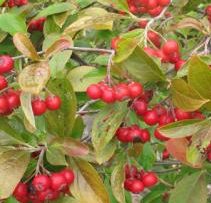 A native of thickets in wet areas such as bogs and swamps from Nova Scotia to Florida and west to Michigan, Missouri, and Texas, this deciduous shrub grows 6-10′ tall and has reddish brown exfoliating bark. The elliptic, 3-5″ long leaves are glossy dark green above, pubescent grayish-green beneath, and turn bright red in the fall. In spring, plants bear clusters of white t0 pale pink flowers that are 1/3″ across and have 5 petals. The flowers are attractive to butterflies and other pollinators and are followed by glossy red berries 1/4″ across that are edible but so astringent that they are usually not eaten by most wildlife and persist into winter. Red chokeberry tolerates drought but does not do well in dry, shallow, alkaline soil. It is leggy but suckers freely and can form a substantial clump that looks well at a woodland’s edge or along the edges of a steam or pond. Red chokeberry is a good choice for borders, streamside, woodland and butterfly gardens.
A native of thickets in wet areas such as bogs and swamps from Nova Scotia to Florida and west to Michigan, Missouri, and Texas, this deciduous shrub grows 6-10′ tall and has reddish brown exfoliating bark. The elliptic, 3-5″ long leaves are glossy dark green above, pubescent grayish-green beneath, and turn bright red in the fall. In spring, plants bear clusters of white t0 pale pink flowers that are 1/3″ across and have 5 petals. The flowers are attractive to butterflies and other pollinators and are followed by glossy red berries 1/4″ across that are edible but so astringent that they are usually not eaten by most wildlife and persist into winter. Red chokeberry tolerates drought but does not do well in dry, shallow, alkaline soil. It is leggy but suckers freely and can form a substantial clump that looks well at a woodland’s edge or along the edges of a steam or pond. Red chokeberry is a good choice for borders, streamside, woodland and butterfly gardens.
Type: Deciduous shrub
Height: 6-10
Light: Full sun
Soil: Average, well-drained, slightly acidic; tolerates both wet and dry soils.
Hardiness: Zones 4-9
Japaese Barberry (Berberis thunbergii)
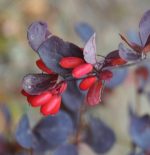 Japanese barberry is a thorny, deciduous shrub that grows 3-6’ tall and forms dense stands in open woods woodland borders, pastures, fields, and disturbed areas such as waste lots, and have become invasive from Maine too Manitoba, south to Georgia and Kansas. The obvate green leaves are up to 1 ¼” long and turn yellow to red in the fall. Pendent clusters of pale yellow flowers appear in spring and give way to small red berries that persist into winter and are attractive to birds. Plants are very adaptable and tolerate shade, heat, drought, and urban conditions. They respond well to pruning and are especially useful for barrier hedges. Several cultivars are available that vary most significantly in height and color of foliage.
Japanese barberry is a thorny, deciduous shrub that grows 3-6’ tall and forms dense stands in open woods woodland borders, pastures, fields, and disturbed areas such as waste lots, and have become invasive from Maine too Manitoba, south to Georgia and Kansas. The obvate green leaves are up to 1 ¼” long and turn yellow to red in the fall. Pendent clusters of pale yellow flowers appear in spring and give way to small red berries that persist into winter and are attractive to birds. Plants are very adaptable and tolerate shade, heat, drought, and urban conditions. They respond well to pruning and are especially useful for barrier hedges. Several cultivars are available that vary most significantly in height and color of foliage.
Type: Deciduous shrub
Height: 3-6′
Light: Full sun but tolerate some shade
Soil: Average, dry to medium, well-drained
Hardiness: Zones 4-8
Photo Credit: Wikipedia
Beautyberry (Callicarpa japonica)
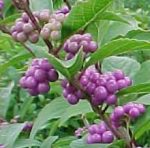 This cascading deciduous shrub is native to China, Taiwan, Japan, Korea, and Ryuku Islands. It grows 4-6′ tall and wide, and has long, slender arching branches carrying medium green, leaves that are 3-5″ long, elliptical to ovate-lanceolate, and have finely toothed margins. In summer, cymes of small, inconspicuous pink to white flowers appear that are attractive to bees and butterflies. In fall as the leaves turn yellow to violet, purplish or pink, axial clusters of showy violet to purple fruits 1/6″ across appear. The fruits may persist beyond leaf drop and are attractive to birds. The combination of fruit and leaf coloration in the fall can be noteworthy and beautyberry is a good choice for border, hedge, woodland areas, and bird garden. Stems of berries are lovely in fresh arrangements.
This cascading deciduous shrub is native to China, Taiwan, Japan, Korea, and Ryuku Islands. It grows 4-6′ tall and wide, and has long, slender arching branches carrying medium green, leaves that are 3-5″ long, elliptical to ovate-lanceolate, and have finely toothed margins. In summer, cymes of small, inconspicuous pink to white flowers appear that are attractive to bees and butterflies. In fall as the leaves turn yellow to violet, purplish or pink, axial clusters of showy violet to purple fruits 1/6″ across appear. The fruits may persist beyond leaf drop and are attractive to birds. The combination of fruit and leaf coloration in the fall can be noteworthy and beautyberry is a good choice for border, hedge, woodland areas, and bird garden. Stems of berries are lovely in fresh arrangements.
Type: Deciduous shrub
Height: 4-6′
Light: Full sun to part sun but best berry production in full sun
Soil: Average, moderately moist well-drained; tolerates less.
Hardiness: Zones 5-8
White Fringetree (Chionanthus virginicus)
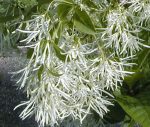
This native of woodland edges, stream banks, and roadsides from Massachusetts, Kentucky, and Missouri south to Florida and west to Texas, is a small deciduous shrub or tree with a spectacular bloom in late spring. Growing 12-35 feet tall, usually 20 feet, fringetree may be single or multi-stemmed, and bears masses of fragrant white flowers before or about the same time that the leaves appear. Each flower has 4-6 petals 1 inch long that hang so as to give it the appearance of fringe or beards giving the tree two common names including old man’s beard. Fringetree is usually dioecious (male and female flowers on different trees) with the male flowers being more showy than female. The female flowers, however, give way to blue-black berries that are attractive to birds and other wildlife. The leaves are glossy oval leaves are lanceolate and turn yellow in fall but drop quickly so do not add much to autumn coloration. Fringetree is an excellent specimen tree, does especially well in woodland borders, and is successful in containers. It is tolerant of air pollution but not tolerant of long periods of drought.
Type: Flowering deciduous shrub or small tree
Height: 12-35
Light: Full sun to partial shade; tolerates dense shade
Soil: Humus-rich, moist, well-drained, acidic to neutral
Hardiness: Zones 4-9
Photo Credit:Wikimedia Commons
Smokebush (Cotinus) ‘Flame’
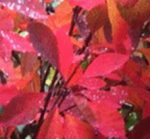 Smokebush ‘Flame’ is hybrid resulting from a cross between Cotinus coggygria, a native to Asia, and C. obovatus, native to southern US. Growing 10-15′ tall, this vigorous, bushy, deciduous shrub has simple, blue gray foliage that is attractive all summer but presents an outstanding autumn display of bright orange-red foliage. Panicles of small purplish pink flowers appear after the flowers of most spring blooming trees and shrubs and before the summer blooming ones. Smokebush ‘Flame’ is tough and can be grown in parking lots as well as garden beds and containers. Once established it is drought tolerant and can be used in dry rocky soils without irrigation.
Smokebush ‘Flame’ is hybrid resulting from a cross between Cotinus coggygria, a native to Asia, and C. obovatus, native to southern US. Growing 10-15′ tall, this vigorous, bushy, deciduous shrub has simple, blue gray foliage that is attractive all summer but presents an outstanding autumn display of bright orange-red foliage. Panicles of small purplish pink flowers appear after the flowers of most spring blooming trees and shrubs and before the summer blooming ones. Smokebush ‘Flame’ is tough and can be grown in parking lots as well as garden beds and containers. Once established it is drought tolerant and can be used in dry rocky soils without irrigation.
Type: Deciduous flowering shrub
Height: 10-15′
Light: Full sun
Soil: Average, moderately moist, well-drained; drought tolerant when established
Hardiness: Zones 5b-8
Redbud Hazel (Disanthus cercidifolius)
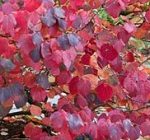
Native to the woodlands of China and Japan, this slender, branched, deciduous shrub grows up to 10′ tall, and has blue-green heart-shaped leaves 2-4″ wide that turn dark yellow, orange, red, and purple as temperatures cool. In the fall, plants produce tiny purplish 5-petaled flowers that have are starfish-shaped, 3/4″ wide, and mildly fragrant. The fruit is a 2-lobed capsule containing several glossy black seeds and ripens the following fall. Plants are note worthy for producing good fall color in light shade but should be protected from wind that will damage the foliage. They are a good choice for borders, cottage gardens, and nautalized areas.
Type: Deciduous shrub
Height: 10′
Light: Light shade; tolertes less
Soil: Average, consistently moist, well-drained, acidic
Hardiness: Zones 5-8
White Enkianthus aka dodan-tsutsuji (Enkianthus perulatus)
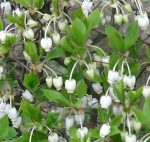 White enkianthus is a compact, deciduous, flowering shrub native to the woodlands of Japan. It grows up to 6′ tall and wide and has shiny red twigs, reddish brown twigs, and branches arranged in tiers. The bright green, ovate leaves are 1-2″ long and clustered at the tips of the branches. In the fall the the leaves turn burgundy and then bright yellow and scarlet, but plants are variable and best purchased in the fall when the color can be evaluated. In spring, before the leaves emerge, pendent umbels of 3-10 small, pure white, urn-like flowers appear. White enkianthus is valued for both its flowers and spectacular fall coloration and is a good choice for containers, borders, hedges, and woodland gardens.
White enkianthus is a compact, deciduous, flowering shrub native to the woodlands of Japan. It grows up to 6′ tall and wide and has shiny red twigs, reddish brown twigs, and branches arranged in tiers. The bright green, ovate leaves are 1-2″ long and clustered at the tips of the branches. In the fall the the leaves turn burgundy and then bright yellow and scarlet, but plants are variable and best purchased in the fall when the color can be evaluated. In spring, before the leaves emerge, pendent umbels of 3-10 small, pure white, urn-like flowers appear. White enkianthus is valued for both its flowers and spectacular fall coloration and is a good choice for containers, borders, hedges, and woodland gardens.
Type: Deciduous shrub
Height: 6′
Light: Full sun to partial shade
Soil: Average, mediummoist, well-drained, acidic
Hardiness: Zones 6-8
Photo Credit: Wikimedia
Burning Bush (Euonymus alatus)
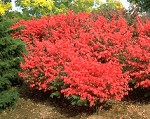 The bright red color of these shrubs in the fall says it all! Nothing heralds fall more loudly and beautifully than these wonderful bushes that can be planted as a formal or informal hedge, specimen plant, foundation planting, or at water’s edge for their fantastic reflection (but they will not tolerate wet feet.). Also called spindle tree and winged euonymus, burning bush is a deciduous shrub native to China, Japan and Korea. It grows up to 8′ tall and has stems with corky appendages when mature, and elliptic to obovate, toothed leaves up to 3″ long. The inconspicuous spring flowers are yellowish green and give way to small red fruits that are 1.3″ long and ripen in the fall. When the capsules open tiny seeds with fleshy orange-red arils (outgrowths) appear and are attractive to some birds. Burning bush has been a very popular plant but is considered an invasive species in some areas.
The bright red color of these shrubs in the fall says it all! Nothing heralds fall more loudly and beautifully than these wonderful bushes that can be planted as a formal or informal hedge, specimen plant, foundation planting, or at water’s edge for their fantastic reflection (but they will not tolerate wet feet.). Also called spindle tree and winged euonymus, burning bush is a deciduous shrub native to China, Japan and Korea. It grows up to 8′ tall and has stems with corky appendages when mature, and elliptic to obovate, toothed leaves up to 3″ long. The inconspicuous spring flowers are yellowish green and give way to small red fruits that are 1.3″ long and ripen in the fall. When the capsules open tiny seeds with fleshy orange-red arils (outgrowths) appear and are attractive to some birds. Burning bush has been a very popular plant but is considered an invasive species in some areas.
Type: Decidous shrub
Height: 8′
Light: Full sun to shade but best color in full sun
Soil: Average, medium moist, well-dained, acidic; does not tolerte wet feet.
Hardiness: Zones 3-9
Fothergill (Fothergill gardenii)
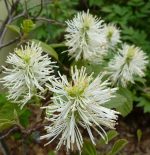 Native to moist areas of Southeast US, this compact deciduous shrub grows up to 4′ tall and wide, and has dark green, oblong to ovate, pubescent leaves that are up to 2.5″ long and have teeth along their upper margins. In the fall the leaves turn vibrant yellow, orange, red, and violet. In spring, before the leaves apper, dense, terminal bottle brush-like spikes of flowers emerge. The spikes are 1-2″ long and the flowers are white tinged wth green when first open. The flowers are fragrant but lack petals and have conspicous stamens that create the brush like appearance. The plants bloom with the dogwoods, azaleas, and cherry trees and are especially appealing. The flowers are good in fresh arrangements.
Native to moist areas of Southeast US, this compact deciduous shrub grows up to 4′ tall and wide, and has dark green, oblong to ovate, pubescent leaves that are up to 2.5″ long and have teeth along their upper margins. In the fall the leaves turn vibrant yellow, orange, red, and violet. In spring, before the leaves apper, dense, terminal bottle brush-like spikes of flowers emerge. The spikes are 1-2″ long and the flowers are white tinged wth green when first open. The flowers are fragrant but lack petals and have conspicous stamens that create the brush like appearance. The plants bloom with the dogwoods, azaleas, and cherry trees and are especially appealing. The flowers are good in fresh arrangements.
Type: Deciduous flowering shrub
Height: 1.5-4′
Light: Full sun to part shade
Soil: Average, evenly moist, well-drained, acidic soil but tolerates less than ideal conditions.
Hardiness: Zones 5-8
Photo Credit: Wikimedia
Ozark Witch Hazel (Hamamelis vernalis)
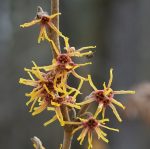 Ozark witch hazel is a deciduous flowering shrub or small tree native to the Ozark Plateau from southern Missouri through northwestern Arkansas east to Oklahoma where it grows in moist areas and can form large colonies. It grows up to 10′ tall and havas zig zag twigs and thick, ovate to rounded leaves up to 4″ long with deeply crenate margins, conspicuous sunken veins, and a short petiole. The leaves emerge medium to dark green but become golden-yellow in the fall although some cultivars may turn orange, red, and purple. In mid to late winter before the foliage emerges, fragrant flowers appear in axillary clusters. The flowers range in color from pale yellow to orange and red-orange, and have four, narrow, ribbon-like petals that are 1/3″ long and roll up on cold days, roll out on warm ones. The fruit is a 2-valved capsule that is produced in late summer and perists into winter. Ozark witch hazel provides very welcome interest in winter and is a good choice for a shrub border, screen, hedge, woodland or winter garden. Flowers can be forced for the vase.
Ozark witch hazel is a deciduous flowering shrub or small tree native to the Ozark Plateau from southern Missouri through northwestern Arkansas east to Oklahoma where it grows in moist areas and can form large colonies. It grows up to 10′ tall and havas zig zag twigs and thick, ovate to rounded leaves up to 4″ long with deeply crenate margins, conspicuous sunken veins, and a short petiole. The leaves emerge medium to dark green but become golden-yellow in the fall although some cultivars may turn orange, red, and purple. In mid to late winter before the foliage emerges, fragrant flowers appear in axillary clusters. The flowers range in color from pale yellow to orange and red-orange, and have four, narrow, ribbon-like petals that are 1/3″ long and roll up on cold days, roll out on warm ones. The fruit is a 2-valved capsule that is produced in late summer and perists into winter. Ozark witch hazel provides very welcome interest in winter and is a good choice for a shrub border, screen, hedge, woodland or winter garden. Flowers can be forced for the vase.
Type: Decidous flowering shrub
Height: 10′
Light: Full sun to partial shade
Soil: Average, medium moist, well-drained, acidic; tolerates clay soil if well drained.
Hardiness: Zones 4-8
Photo Credit:Wikipedia
Virgina Sweetspire (Itea virginica)
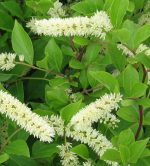 Virginia sweetspire is a deciduous to semievergreen shrub native to eastern North America from New Jersey and Missouri south to Florida and Louisiana where it grows on stream and pond margins, swamps, and low woods. The arching branches form a spreading shrub with lustrous oval leaves up to four inches long that are serrated and mid- to dark green until fall when they turn gold, orange, and red and purple, persisting well into early winter. In late spring to early summer fragrant white flowers appear in pendulous cylindrical racemes three to six inches long. The plants are tolerant of various light and soil conditions and are a good choice for a specimen, shrub border, and ground cover as well as along stream borders, on slopes, and included in a rain garden or woodland garden. The cultivar ‘Henry’s Garnet’ is more widely available than the species and boasts more compact form, larger more showy flowers, and better fall coloration.
Virginia sweetspire is a deciduous to semievergreen shrub native to eastern North America from New Jersey and Missouri south to Florida and Louisiana where it grows on stream and pond margins, swamps, and low woods. The arching branches form a spreading shrub with lustrous oval leaves up to four inches long that are serrated and mid- to dark green until fall when they turn gold, orange, and red and purple, persisting well into early winter. In late spring to early summer fragrant white flowers appear in pendulous cylindrical racemes three to six inches long. The plants are tolerant of various light and soil conditions and are a good choice for a specimen, shrub border, and ground cover as well as along stream borders, on slopes, and included in a rain garden or woodland garden. The cultivar ‘Henry’s Garnet’ is more widely available than the species and boasts more compact form, larger more showy flowers, and better fall coloration.
Type: Deciduous flowering shrub
Height: 6′ ( Henry’s Garnet 3-4’)
Light: Sun to part shade
Soil: Average, medium to wet, well-drained
Hardiness: Zones 5-9
Spicebush (Lindera bensoin)
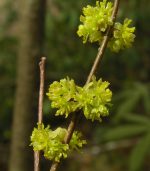 This deciudous flowering shrub is native to eastern North America from Maine to northern Florida and west to Ontaraio, Kansas, and Texas where it grows in moist areas of woods espically where there is exposed limestone. Plants grow 6-12′ tall and have aromatic, brown to gray-brown stems sprinkled with circular lenticels, and thick light green leaves that are 3-6″ long, oblong-obvate and turn bright yellow in the fall. The leaves provide food for the larvae of the spicebush swallowtail butterfly. Clusters of tiny, greenish-yellow male and female flowers appear in separate plants in early spring before the leaves emerge. The flowers are aromatic, lack petals and the male flowers are larger and showier than the female ones. Female flowers give way to bright red berries in the fall that are 1/2″ long and attractive to birds. The plants are easy to grow and are a good choice for woodland, native plant, wildlife, bird, and butterfly gardens.
This deciudous flowering shrub is native to eastern North America from Maine to northern Florida and west to Ontaraio, Kansas, and Texas where it grows in moist areas of woods espically where there is exposed limestone. Plants grow 6-12′ tall and have aromatic, brown to gray-brown stems sprinkled with circular lenticels, and thick light green leaves that are 3-6″ long, oblong-obvate and turn bright yellow in the fall. The leaves provide food for the larvae of the spicebush swallowtail butterfly. Clusters of tiny, greenish-yellow male and female flowers appear in separate plants in early spring before the leaves emerge. The flowers are aromatic, lack petals and the male flowers are larger and showier than the female ones. Female flowers give way to bright red berries in the fall that are 1/2″ long and attractive to birds. The plants are easy to grow and are a good choice for woodland, native plant, wildlife, bird, and butterfly gardens.
Type: Deciduous flowering shrub
Height: 6-12′
Light: Full sun to partial shade
Soil: Average, medium moist, well-drained
Hardiness: Zones 4-9
Photo Credit:Wikipedia
Royal Azalea (Rhododendron schlippenbachii)
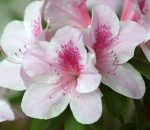 This dense flowering deciduous shrub is native to Korea, Manchuria, Japan and far east Russia where it grows in the understory of mountain forests. It is a member of the heath family, Ericaceae, that also includes heather, blueberry and andromeda. Plants grows 4-6′ tall and have 2-6″ long, obovate leaves that appear in terminal whorls and provide yellow, orange, and red coloration in the fall. Clusters of 3-6 funnel-shaped flowers emerge as the leaves appear and are white tinged with pink, fragrant and up to 3.5″ across. The flowers are attractive to butterflies and hummingbirds and is a good choice for border, hedge, screen, and woodland, butterfly, and wildife gardens. All parts of the plant are poisonous to humans.
This dense flowering deciduous shrub is native to Korea, Manchuria, Japan and far east Russia where it grows in the understory of mountain forests. It is a member of the heath family, Ericaceae, that also includes heather, blueberry and andromeda. Plants grows 4-6′ tall and have 2-6″ long, obovate leaves that appear in terminal whorls and provide yellow, orange, and red coloration in the fall. Clusters of 3-6 funnel-shaped flowers emerge as the leaves appear and are white tinged with pink, fragrant and up to 3.5″ across. The flowers are attractive to butterflies and hummingbirds and is a good choice for border, hedge, screen, and woodland, butterfly, and wildife gardens. All parts of the plant are poisonous to humans.
Type: Flowering deciduous shrub
Height: 4-6′
Light: Partial shade (dappled and high shade best)
Soil: Average, medium moist, well-drained, acidic but tolerates less acid soil than most azaleas.
Hardiness: Zones 4-8
Photo Credit: Wikipedia
Winged Sumac (Rhus copallina)
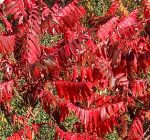 Native to Eastern United States, winged sumac is also called flamesumac and is a tough shrub or small tree that is found on forest edges, old fields, meadows and roadsides. It grows quickly and suckers form colonies that are appealing when in bloom or fruit. The tiny greenish cream colored flowers are borne in pyramidal clusters 6-10” long above rings of foliage in summer and develop into showy pendulous, red fruit clusters that are attractive to birds into winter. The shiny leaves are a foot long and pinnately compound with resinous red stems. The leaf stems are winged between the leaflets giving rise to the common name. In fall the leaves turn orange-red to purple and add considerably to autumn coloration. Winged sumac is adaptable, can be grown a variety of soils and tolerates drought, heat, compaction, air and soil-borne salt. If grown in mass it provides a good wildlife habitat. A good plant for a screen, xeroscape, or informal planting.
Native to Eastern United States, winged sumac is also called flamesumac and is a tough shrub or small tree that is found on forest edges, old fields, meadows and roadsides. It grows quickly and suckers form colonies that are appealing when in bloom or fruit. The tiny greenish cream colored flowers are borne in pyramidal clusters 6-10” long above rings of foliage in summer and develop into showy pendulous, red fruit clusters that are attractive to birds into winter. The shiny leaves are a foot long and pinnately compound with resinous red stems. The leaf stems are winged between the leaflets giving rise to the common name. In fall the leaves turn orange-red to purple and add considerably to autumn coloration. Winged sumac is adaptable, can be grown a variety of soils and tolerates drought, heat, compaction, air and soil-borne salt. If grown in mass it provides a good wildlife habitat. A good plant for a screen, xeroscape, or informal planting.
Type: Deciduous shrub or small tree
Height: 6-30′
Light:Full sun, light shade
Soil: Lean to humus-rich, moist to dry, neutral to acidic
Hardiness: Zones 4-8
Bridalwreath Spirea (Spirea prunifolia)
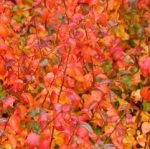 This flowering deciduous shrub is native to China, Taiwan and Korea where it grows on hillsides and stony, baren places in full sun. It is a member of the rose family, Rosaceae that also includes cherry, almond, and lady’s mantle. Growing 4-9′ tall and wide, the plant is open and leggy and has slender slightly zig-zag arching stems. The shiny elliptic to oblong leaves are 1-3″ long, finely toothed, and blue-green often turning yellow orange and purplish bronze in the fall when grown in the sun. A profusion of double, 1/3″ wide flowers appear in axillary umbellate clusters of 3-6 in spring before the leaves appear and are white with touches of green. The flowers are attractive to butterflies and flowering stems can be used to form head wreaths. The plants are a good choice for a border, hedge, or butterfly garden.
This flowering deciduous shrub is native to China, Taiwan and Korea where it grows on hillsides and stony, baren places in full sun. It is a member of the rose family, Rosaceae that also includes cherry, almond, and lady’s mantle. Growing 4-9′ tall and wide, the plant is open and leggy and has slender slightly zig-zag arching stems. The shiny elliptic to oblong leaves are 1-3″ long, finely toothed, and blue-green often turning yellow orange and purplish bronze in the fall when grown in the sun. A profusion of double, 1/3″ wide flowers appear in axillary umbellate clusters of 3-6 in spring before the leaves appear and are white with touches of green. The flowers are attractive to butterflies and flowering stems can be used to form head wreaths. The plants are a good choice for a border, hedge, or butterfly garden.
Type: Deciduous flowering shrub
Height: 4-9′
Light: Full sun; tolerates light shade but best color is in full sun
Soil: Average, medium moist, well-drained; drought tolerant once established
Hardiness: Zones 5-8
Highbush Blueberry (Vaccinium corymbosum)
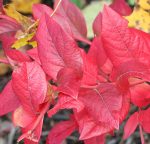 This deciduous shrub is known by several names including blue huckleberry and swamp huckleberry and is a member of the heath family, Ericaceae, that also includes heather, cranberries, and azaleas. It is native to eatern Canada and eastern and southern US from Ontaria and Nova Scotia to Florida and eastern Texas where it grows in bogs, swamps, and high elevation forests with acidic soil (pH 4.5-5.5). Plants grow 6-12′ tall and have elliptical, 2″ long leaves that are reddish-green in spring, blue-green in summer with lighter undersides, and turn red, yellow, orange and purple in the fall. Deer and rabbits browse the foliage. In spring, plants produce clusters of urn-shaped, pale pink flowers that are 1/3″ long and have fused petals. Blue-black berries 1/4-1/2″ in diameter appear in the fall and are attractive to birds. small mammals, and bears. Highbush blueberry is a good choice for fruit production, a hedge, border, wildlife and native plant gardens.
This deciduous shrub is known by several names including blue huckleberry and swamp huckleberry and is a member of the heath family, Ericaceae, that also includes heather, cranberries, and azaleas. It is native to eatern Canada and eastern and southern US from Ontaria and Nova Scotia to Florida and eastern Texas where it grows in bogs, swamps, and high elevation forests with acidic soil (pH 4.5-5.5). Plants grow 6-12′ tall and have elliptical, 2″ long leaves that are reddish-green in spring, blue-green in summer with lighter undersides, and turn red, yellow, orange and purple in the fall. Deer and rabbits browse the foliage. In spring, plants produce clusters of urn-shaped, pale pink flowers that are 1/3″ long and have fused petals. Blue-black berries 1/4-1/2″ in diameter appear in the fall and are attractive to birds. small mammals, and bears. Highbush blueberry is a good choice for fruit production, a hedge, border, wildlife and native plant gardens.
Type: Deciduous shrub
Height: 6-12′
Light: Full sun to part shade
Soil: Average, medium moist to wet, well-drained, acidic (pH4.-5.5 depending on the cultivar)
Hardiness: Zones 5-8
Photo Credit: Randy Nonenmacher, Wikipedia
Arrowwood (Viburnum dentata)
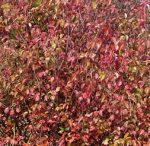 Native to grasslands, woodlands, marshes, swamps and shores of rivers and lakes from Massachusetts south to Florida and west to Texas this deciduous shrub grows 5-10′ tall and wide, and has ovate leaves that are 2-4″ long, and have coarsely toothed margins. The uppersides of the leaves are yellow to dark green on the upperside and pale green with prominent veins on the lower side, but in the fall turn dull yellow to attractive orange or red, depending on the plant. In spring the plants produce 4″ wide flat-topped flowerheads of creamy white bell-shaped flowers that are 1/4″ across and have 5 petals and extruded stamens with yellow anthers. The flowers are attractive to bees and butterflies. In late summer to early fall bluish-black fruits appear that are attractive to birds. Fruit set requires more than one genetic strain. Arrowhead tolerates a variety of soil and pH types and can be used along a stream, pond or bog, as a specimen, foundation shrub, screen or hedge, and in a wildlife, butterfly, or native plant garden.
Native to grasslands, woodlands, marshes, swamps and shores of rivers and lakes from Massachusetts south to Florida and west to Texas this deciduous shrub grows 5-10′ tall and wide, and has ovate leaves that are 2-4″ long, and have coarsely toothed margins. The uppersides of the leaves are yellow to dark green on the upperside and pale green with prominent veins on the lower side, but in the fall turn dull yellow to attractive orange or red, depending on the plant. In spring the plants produce 4″ wide flat-topped flowerheads of creamy white bell-shaped flowers that are 1/4″ across and have 5 petals and extruded stamens with yellow anthers. The flowers are attractive to bees and butterflies. In late summer to early fall bluish-black fruits appear that are attractive to birds. Fruit set requires more than one genetic strain. Arrowhead tolerates a variety of soil and pH types and can be used along a stream, pond or bog, as a specimen, foundation shrub, screen or hedge, and in a wildlife, butterfly, or native plant garden.
Type: Deciduous shrub
Height: 5-10′
Light:Full sun to partial shade
Soil: Average, moist, well-drained; tolerates less
Hardiness: Zones 2-8
Type:
Height:
Light:
Soil:
Hardiness: Zones
Photo Credit:
Type:
Height:
Light:
Soil:
Hardiness: Zones
Photo Credit:
Type:
Height:
Light:
Soil:
Hardiness: Zones
Photo Credit:
Type:
Height:
Light:
Soil:
Hardiness: Zones
Photo Credit: